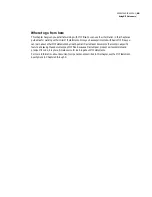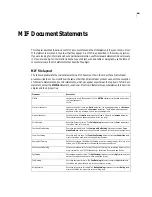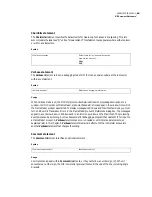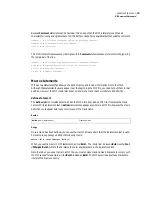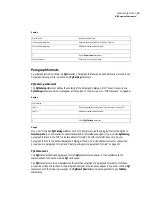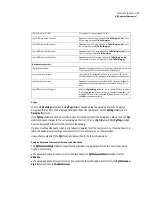
67
ADOBE FRAMEMAKER 6.0
MIF Document Statements
TblCatalog
Describes table formats. The
TblCatalog
statement contains
TblFormat
statements
that define the properties and tag for each table format.
Views
Describes color views for the document. The
Views
statement contains
View
state-
ments that define which colors are visible in each color view.
VariableFormats
Defines variables.The
VariableFormats
statement contains
VariableFormat
state-
ments that define each variable.
MarkerTypeCatalog
Defines a catalog of user-defined markers for the current document. The
MarkerType-
Catalog
statement contains
MarkerTypeCatalog
statements that specify each
user-defined marker.
XRefFormats
Defines cross-reference formats. The
XRefFormats
statement contains
XRefFormat
statements that define each cross-reference format.
Document
Controls document features such as page size, margins, and column layout. Because
the MIF interpreter assumes the same page defaults as the New command, this section
is necessary only if you want to override those default settings.
BookComponent
Provides the setup information for files generated from the document.
BookCompo-
nent
statements describe the filename, filename suffix, file type, and paragraph tags
or marker types to include.
InitialAutoNums
Provides a starting value for the autonumber series in a document.
Dictionary
Lists allowed words in the document.
AFrames
Describes all anchored frames in the document. The
AFrames
statement contains
Frame
statements that define the contents ID number of each anchored frame. Later
in the MIF file, where the document contents are described, the MIF file must include
an
AFrame
statement that corresponds to each
Frame
statement. The
AFrame
state-
ment identifies where a specific anchored frame appears in a text flow; it need only sup-
ply the frame’s ID number.
Tbls
Describes all tables in the document. The
Tbls
statement contains
Tbl
statements that
define the contents of each table and its ID number. Later in the MIF file, where the
document contents are described, the MIF file must include a short
ATbl
statement that
corresponds to each
Tbl
statement. The
ATbl
statement identifies where a specific
table appears in a text flow; it need only supply the table’s ID number.
Page
Describes the layout of each page in the document. The description includes the layout
of each page, the dimensions of the text frames, and the objects and other graphic
frames on that page. A MIF file created by a FrameMaker product includes a
Page
statement for each page in the document, including the master pages. When you write
an import filter, you can omit
Page
statements; the MIF interpreter repaginates the doc-
ument as needed.
TextFlow
Represents the actual text in the document. Within
TextFlow
statements, the text is
expressed in paragraphs which in turn contain paragraph lines. Line endings of
Para-
Line
statements are not significant because the MIF interpreter wraps the contents of
ParaLine
statements into paragraphs.
Statement
Description
Summary of Contents for FRAMEMAKER 6.0
Page 1: ...MIF Reference Online Manual FrameMaker 6 0 Adobe ...
Page 15: ...15 ADOBE FRAMEMAKER 6 0 Introduction ...
Page 159: ...159 ADOBE FRAMEMAKER 6 0 MIF Book File Statements ...
Page 232: ...232 ADOBE FRAMEMAKER 6 0 MIF Asian Text Processing Statements ...
Page 252: ...252 ADOBE FRAMEMAKER 6 0 Examples ...













